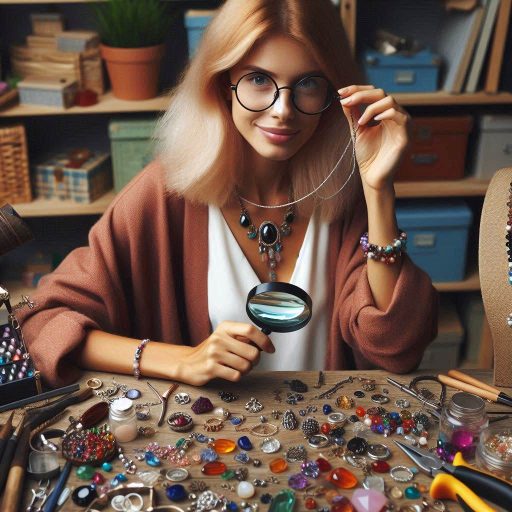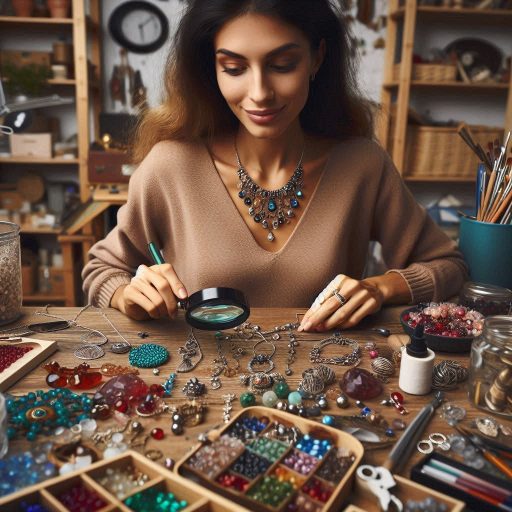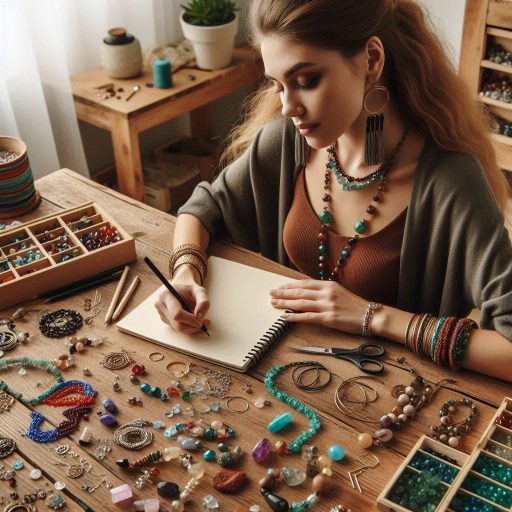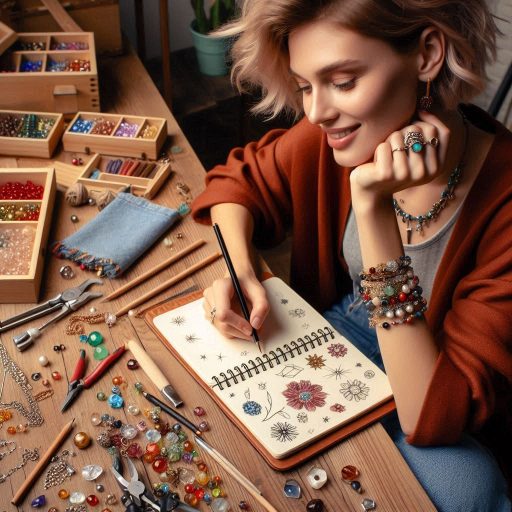Introduction
Working with precious metals in jewelry design is essential for creating exquisite pieces.
These metals, including gold, silver, and platinum, provide beauty and durability.
Jewelry made from precious metals often carries significant value, both emotionally and financially.
The right choice of metal can elevate a design, making it timeless.
Designers often choose these metals for their unique properties and aesthetic appeal.
Therefore, understanding how to work with precious metals is crucial for success in the jewelry industry.
Overview of the Importance of Working with Precious Metals in Jewelry Design
Precious metals are integral to the world of jewelry design.
They offer unmatched beauty, brilliance, and longevity.
Jewelry crafted from these metals retains value over time, making it an investment for buyers.
Precious metals can also be alloyed with other materials, enhancing their properties and versatility.
For example, mixing gold with copper creates rose gold, a popular choice in modern designs.
The unique characteristics of each metal allow for diverse creative expressions.
Designers can create intricate patterns, textures, and finishes that captivate the eye.
Ultimately, the importance of precious metals lies in their ability to transform a simple design into a stunning work of art.
Why Working with Precious Metals Requires Specific Skills and Techniques
Working with precious metals demands specialized skills and techniques.
These materials are malleable, yet they require precise handling to avoid damage.
Jewelers must understand how to manipulate metals without compromising their integrity.
Techniques like soldering, casting, and engraving require training and practice.
Each method demands attention to detail and an understanding of the materials involved.
Furthermore, different metals respond uniquely to heat and tools.
For example, gold melts at a lower temperature than platinum.
Jewelers must adjust their techniques accordingly to achieve desired results.
Additionally, knowledge of various finishes, such as polishing or oxidizing, enhances a piece’s appeal.
The right finish can make a significant difference in the overall look of the jewelry.
Moreover, safety is paramount when working with precious metals.
Jewelers must use protective gear and adhere to safety protocols to prevent accidents.
Understanding the chemical properties of metals also helps prevent allergic reactions in clients.
These factors highlight the need for comprehensive training in the field.
In fact, working with precious metals in jewelry design is a multifaceted endeavor.
It requires a blend of artistic vision and technical skills.
By mastering the specific techniques associated with these materials, designers can create exceptional jewelry pieces that stand the test of time.
Investing in education and practice is crucial for anyone looking to excel in this art form.
Ultimately, the beauty and value of precious metals make them a vital component in the world of jewelry design.
Types of Precious Metals Used in Jewelry Design
Gold, silver, platinum, and other commonly used metals
Jewelry design thrives on a variety of precious metals, each offering unique attributes and aesthetic qualities.
Gold, silver, and platinum are the most commonly used metals.
Each metal carries its distinct characteristics that influence the design and wearability of the jewelry.
Understanding these metals helps designers create pieces that resonate with their intended audience.
Gold remains the most popular choice for jewelry designers.
Its warm hue and malleability make it ideal for intricate designs.
Gold comes in several purities, including 24K, 18K, and 14K.
Higher karat gold contains more pure gold, which increases its value.
Gold‘s resistance to tarnish ensures that pieces maintain their luster over time.
Additionally, gold can be alloyed with other metals, allowing designers to create unique color variations like rose gold and white gold.
Silver is another favorite among jewelry makers.
Its bright, shiny finish appeals to many consumers, and it‘s more affordable than gold or platinum.
Sterling silver, which consists of 92.5% silver and 7.5% other metals, is the most common form used in jewelry.
Silver is relatively soft, making it easier to work with for detailed designs.
Platinum is hypoallergenic, appealing to those with sensitive skin.
Its natural white sheen requires no additional plating, ensuring longevity and lasting beauty.
This metal is ideal for settings that require high strength, such as engagement rings.
Other precious metals, like palladium and rhodium, also find their place in jewelry design.
Palladium, part of the platinum group, shares many characteristics with platinum but is lighter and less expensive.
Rhodium is often used as a plating for white gold and silver to enhance their brightness and protect against tarnishing.
Each metal contributes its unique attributes to jewelry, allowing designers to explore various aesthetics and functions.
Characteristics of Each Metal and Their Significance in Jewelry Design
The characteristics of precious metals significantly impact their significance in jewelry design.
Gold‘s timeless appeal continues to attract buyers and collectors alike.
Its rich history and cultural importance make it a symbol of wealth and status.
Designers often choose gold for heirloom pieces, ensuring that these items carry sentimental value across generations.
Silver‘s affordability allows designers to experiment with innovative designs without significant financial risk.
Its reflective qualities can enhance the beauty of gemstones, making it a favorite choice for accentuating colorful elements in jewelry.
Moreover, silver‘s versatility enables it to adapt to various styles, from traditional to contemporary.
Platinum’s strength and durability make it a preferred metal for engagement and wedding rings.
Its ability to withstand daily wear while maintaining beauty is unparalleled.
Designers leverage platinum‘s qualities to create intricate settings that highlight precious stones, providing a secure and lasting foundation for their designs.
In summary, understanding the different types of precious metals used in jewelry design is crucial for any designer.
Each metal offers unique characteristics that can influence design choices and the overall aesthetic appeal.
By considering these factors, designers can create stunning pieces that resonate with clients and stand the test of time.
Techniques for Working with Precious Metals
Basic Jewelry Making Techniques
Casting is a popular technique where molten metal is poured into a mold to create a specific shape.
This method allows for intricate designs and unique pieces to be made.
Soldering, on the other hand, involves joining metal pieces together using a high-temperature solder.
This technique is essential for connecting different components of a jewelry piece seamlessly.
Stone setting is the process of securing gemstones onto metal settings.
This requires precision and skill to ensure stones are secure and aligned properly.
Precision and Attention to Detail
Working with precious metals requires a high level of precision and attention to detail.
Every cut, bend, or solder joint must be executed with care to achieve the desired outcome.
This is especially crucial when working with valuable materials like gold, silver, or platinum.
Any mistake can be costly and difficult to correct, so it is essential to double-check measurements and alignments throughout the making process.
Attention to detail is necessary not only for the aesthetics of the jewelry piece but also for its structural integrity.
Properly executed techniques ensure that the piece is durable and long-lasting.
Whether it’s setting a stone securely or soldering a delicate connection, the smallest details can make a significant difference in the final result.
Furthermore, precision is key when working with delicate or intricate designs.
This can involve intricate patterns, filigree work, or settings with multiple stones.
Each element must be precisely crafted to maintain the overall balance and beauty of the piece.
This level of precision sets high-quality jewelry apart and showcases the artisan’s skill and expertise.
Overall, mastering these techniques and paying close attention to detail is essential for creating stunning jewelry pieces with precious metals.
Practice, patience, and a commitment to excellence are key to perfecting the craft of working with these valuable materials.
By honing these skills, designers can create exquisite jewelry that shines with beauty and craftsmanship.
Read: Building a Portfolio for Costume Design
Tools Required for Working with Precious Metals
Creating beautiful jewelry from precious metals requires the right tools.
Each tool serves a specific purpose in the jewelry-making process.
Understanding these tools helps both beginners and experienced jewelers enhance their craftsmanship.
List of Essential Tools
Several essential tools are necessary for working with precious metals.
These include torches, hammers, pliers, and files.
Each tool plays a crucial role in shaping and finishing jewelry pieces.
Torches are vital for soldering metals together.
They provide the intense heat needed to melt solder and join metal components.
The right torch allows for precise control over the heat applied to the metal.
Hammers come in various shapes and sizes, serving different functions.
A bench hammer is ideal for shaping metal and adding texture.
A rawhide or plastic hammer prevents damaging the surface of the metal while shaping it.
Pliers, including chain-nose, round-nose, and flat-nose pliers, are essential for manipulating metal.
Chain-nose pliers help grip small components without slipping.
Round-nose pliers assist in creating loops and curves in wire.
Flat-nose pliers are great for bending and holding metal securely.
Files help refine the edges and surfaces of metal pieces.
They remove sharp edges and ensure a smooth finish.
Jewelers use various types of files to achieve different textures and shapes.
Explanation of How Each Tool is Used in the Jewelry Making Process
Understanding how to use each tool effectively is vital for successful jewelry making.
Torches enable jewelers to solder components, allowing for complex designs.
Proper technique ensures strong, lasting bonds between metals.
Hammers shape metals through striking, creating desired forms and textures.
Jewelers must select the appropriate hammer for their specific project.
For instance, a doming hammer creates rounded shapes, while a chasing hammer adds texture.
Pliers are indispensable for manipulating metal components.
They enable jewelers to hold and bend wire accurately.
Using the right pliers minimizes damage to delicate pieces and enhances precision.
Files refine the final shape and finish of jewelry.
After cutting and shaping metal, files remove imperfections and sharp edges.
A smooth finish is crucial for both aesthetics and comfort when wearing jewelry.
Maintaining tools is also essential for effective jewelry making.
Regular cleaning and proper storage prolong the lifespan of tools.
Jewelers should inspect their tools frequently, ensuring they are in good working condition.
By using the right tools, jewelers can transform precious metals into exquisite works of art.
Each tool’s unique function contributes to the overall jewelry-making process.
Investing in quality tools enhances creativity and craftsmanship in jewelry design.
Working with precious metals can be rewarding and fulfilling.
Understanding the tools involved simplifies the learning process for newcomers.
With practice and the right tools, anyone can create stunning jewelry pieces.
Read: Collaborating with Other Creative Roles
Safety Precautions when Working with Precious Metals
Importance of wearing protective gear
When working with precious metals in jewelry design, it is vital to prioritize your safety.
This includes wearing protective gear such as goggles to shield your eyes from potential hazards.
Additionally, using gloves can protect your hands from cuts, burns, or allergic reactions to certain metals.
Proper ventilation and handling of chemicals
Proper ventilation is crucial when working with precious metals, as some metals, when heated or melted, can release toxic fumes that may be harmful when inhaled.
It is essential to work in a well-ventilated area or use a fume hood to ensure the air is clear of any dangerous particles.
Furthermore, when using chemicals in the jewelry making process, it is important to handle them with care.
Always read the labels and follow the instructions for each chemical to avoid any accidents or mishandling.
Store chemicals properly in a designated area away from heat or direct sunlight.
Following safety guidelines
Each precious metal comes with its own set of safety guidelines that should be followed to minimize risks.
Whether you are working with gold, silver, platinum, or other metals, make sure to read and understand the specific precautions recommended by the manufacturer.
By taking proper safety precautions when working with precious metals in jewelry design, you can create stunning pieces while minimizing the risk of accidents or injuries.
Prioritize your safety and well-being to enjoy a fulfilling and successful jewelry making experience.
Remember, a safe workspace is a productive workspace.
Read: Essential Skills for Aspiring Costume Designers
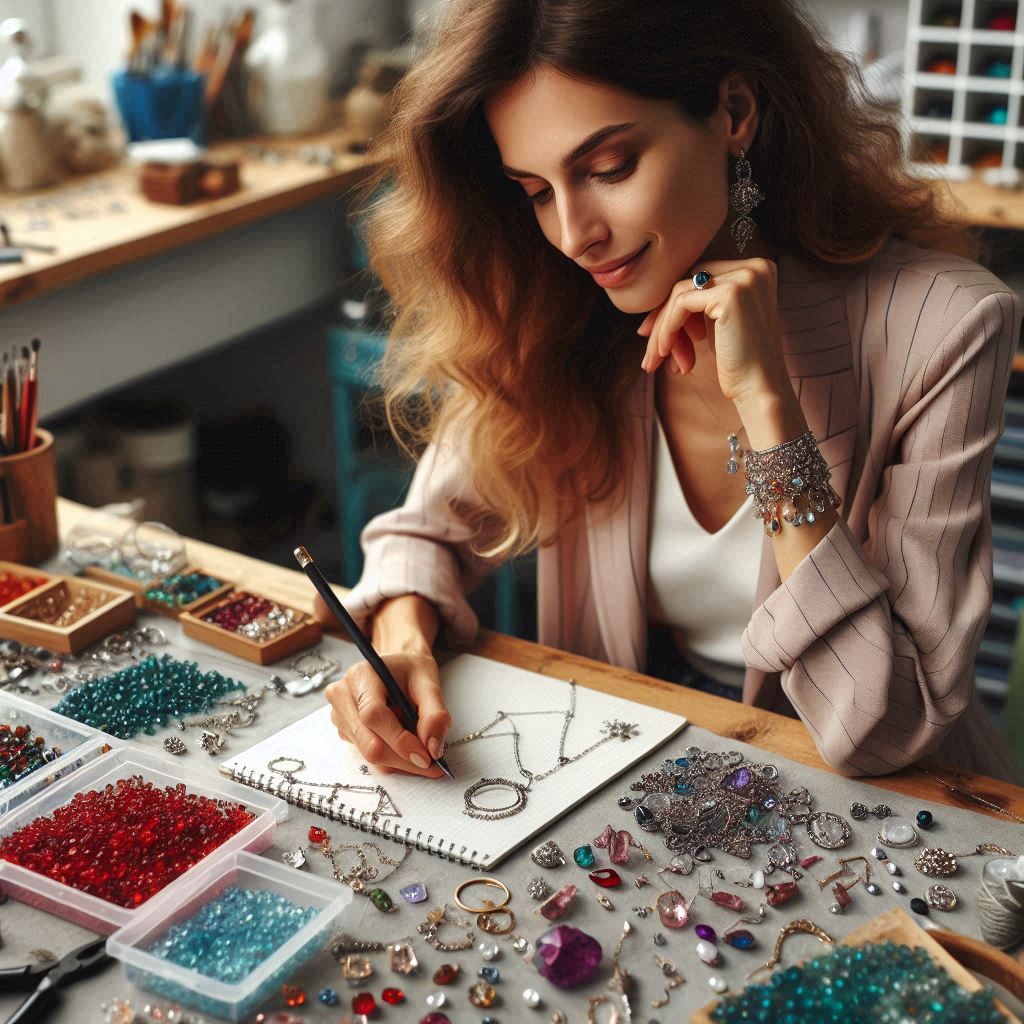
Customization and Personalization in Jewelry Design
How working with precious metals allows for unique and individualized pieces
Working with precious metals like gold, silver, and platinum provides jewelry designers with a wide range of customization options.
These metals can be molded, shaped, engraved, and combined in various ways to create one-of-a-kind pieces.
Precious metals offer durability and versatility, making them ideal for intricate designs and detailed work.
Whether it’s a delicate necklace or a statement ring, precious metals can be manipulated to bring any design vision to life.
Each precious metal has its unique qualities, from the warmth of gold to the brilliance of platinum.
Designers can choose the metal that best complements their design concept, allowing for a personalized touch that reflects the wearer’s style and personality.
Examples of custom jewelry designs created with precious metals
- Custom engagement rings: Precious metals are often used to create unique engagement rings tailored to the couple’s preferences.
Whether it’s a classic solitaire or a modern halo design, precious metals add a luxurious touch to these special pieces. - Personalized bracelets: Customized bracelets featuring initials, symbols, or meaningful dates are popular choices for personalized jewelry.
Precious metals can be intricately engraved or stamped to create a bespoke piece that holds sentimental value. - Customized pendants: Necklaces and pendants are often customized with precious metals to showcase birthstones, initials, or meaningful charms.
These pieces serve as beautiful reminders of special moments or loved ones, making them treasured keepsakes. - Bespoke earrings: Custom earrings crafted with precious metals allow for unique designs that reflect the wearer’s style.
From elegant studs to statement dangles, precious metals elevate the beauty of these accessories, making them stand out.
In a nutshell, working with precious metals in jewelry design offers endless opportunities for customization and personalization.
These metals not only enhance the beauty and value of the pieces but also allow designers to create truly individualized works of art that resonate with their wearers.
Read: Visual Merchandising: Best Practices for Beginners
Market Trends and Demand for Precious Metal Jewelry
When it comes to jewelry design, working with precious metals like gold, silver, and platinum is a timeless tradition that continues to captivate consumers around the world.
Understanding the current market trends and demand for precious metal jewelry is essential for jewelry designers and manufacturers to stay competitive in the industry.
Transform Your Career Today
Unlock a personalized career strategy that drives real results. Get tailored advice and a roadmap designed just for you.
Start NowOverview of Current Trends in the Jewelry Market Related to Precious Metals
- Personalization: Customized designs with initials, birthstones, and meaningful symbols are gaining popularity among consumers who seek unique pieces.
- Mixed Metals: Combining different precious metals such as gold and silver in a single piece creates a modern and versatile look that appeals to a wide audience.
- Minimalist Designs: Clean lines, geometric shapes, and understated elegance are preferred by consumers looking for timeless and versatile jewelry pieces.
- Vintage Revival: Retro-inspired designs from different eras, such as Art Deco or Victorian styles, are making a comeback in the jewelry market.
- Sustainable and Ethical Practices: Consumers are increasingly seeking jewelry made from ethically sourced and recycled precious metals to align with their values.
By staying informed about these market trends, jewelry designers can create collections that resonate with consumers and meet their evolving preferences.
Impact of Economic Factors on the Demand for Precious Metal Jewelry
- Price Fluctuations: The global economy, inflation rates, and currency values directly influence the prices of precious metals, affecting consumer purchasing power.
- Luxury Market Dynamics: Economic downturns may lead to shifts in consumer spending behavior, impacting the demand for high-end jewelry made from precious metals.
- Perceived Value: During uncertain economic times, consumers may view precious metal jewelry as a safe investment due to its enduring value and prestige.
- Consumer Confidence: Economic stability and job security play a critical role in consumer confidence and willingness to splurge on luxury items like precious metal jewelry.
- Demographic Trends: Changing demographics, such as millennials’ preferences for experiences over material possessions, can influence the demand for precious metal jewelry in the market.
By analyzing the impact of economic factors on the demand for precious metal jewelry, industry professionals can adapt their strategies to meet changing consumer behaviors and market conditions.
In essence, staying abreast of market trends and understanding the influence of economic factors is crucial for jewelry designers and manufacturers working with precious metals.
By incorporating consumer preferences and responding to economic shifts, businesses can effectively meet the demand for exquisite precious metal jewelry in a competitive marketplace.
Sustainability and Ethical Sourcing of Precious Metals
As the jewelry industry evolves, sustainability becomes a crucial focus.
Designers increasingly recognize the importance of sourcing precious metals responsibly.
Ethical sourcing ensures that metals come from suppliers who prioritize environmental and social responsibility.
This shift toward ethical practices is essential for creating a positive impact in the jewelry sector.
Consumers are becoming more aware of the origins of their purchases.
They demand transparency and accountability from jewelry makers.
By choosing ethical suppliers, designers can help combat issues like child labor and environmental degradation.
This commitment to sustainability enhances a brand‘s reputation and builds consumer trust.
Many precious metals are sourced from mines that have significant environmental consequences.
Unregulated mining practices can lead to habitat destruction and water pollution.
Moreover, these practices often exploit local communities.
Therefore, designers must consider the environmental and social implications of their sourcing choices.
By opting for sustainable suppliers, they contribute to reducing these negative impacts.
Sustainable sourcing supports fair wages and safe working conditions for miners.
This approach not only benefits communities but also fosters a more responsible industry overall.
In this way, jewelry designers can play an active role in promoting ethical practices.
Importance of Sourcing Metals from Ethical and Sustainable Suppliers
The importance of sourcing metals from ethical and sustainable suppliers cannot be overstated.
Ethical suppliers ensure that their practices align with social and environmental standards.
This alignment helps create a positive cycle of responsible sourcing.
Jewelry designers can feel confident in their materials when they know the sources are ethical.
This knowledge enhances their designs’ integrity and appeal to conscious consumers.
Furthermore, ethical sourcing contributes to sustainable development in mining regions.
It promotes economic growth while protecting the environment.
Sourcing precious metals ethically also addresses consumer demand for sustainability.
Modern consumers prefer brands that align with their values.
By prioritizing ethical sourcing, designers can attract a loyal customer base.
This consumer shift emphasizes the need for jewelry brands to adapt their practices.
Ethical sourcing becomes a competitive advantage in the marketplace.
Designers can differentiate themselves by highlighting their commitment to responsible practices.
By emphasizing these values, they foster a deeper connection with their clients.
Certification Programs and Initiatives Promoting Ethical Practices in the Jewelry Industry
Several certification programs and initiatives promote ethical practices in the jewelry industry.
These programs guide designers in sourcing materials responsibly.
They set standards for environmental and social practices, ensuring compliance among suppliers.
For instance, the Responsible Jewelry Council (RJC) offers certification for companies committed to ethical practices.
This certification assures consumers that the jewelry they purchase aligns with sustainable values.
Other initiatives, such as Fairmined, focus on empowering artisanal miners.
These programs promote fair trade and encourage environmentally responsible mining practices.
By supporting these initiatives, designers can make a significant impact on the communities involved.
They contribute to social change while enhancing their brand’s reputation.
Engaging with certification programs demonstrates a designer’s commitment to sustainability and ethics.
This engagement can enhance consumer trust and loyalty, ultimately benefiting the brand in the long run.
In review, sustainability and ethical sourcing of precious metals play a vital role in jewelry design.
By prioritizing these practices, designers can contribute to a more responsible and sustainable industry.
They can help foster positive change, ensuring a brighter future for both consumers and communities.
Explore Further: Top Challenges Web Designers Face Today
Find Out More: What Does an Art Director Do? Job Duties Explained
Conclusion
Key points discussed in the blog post
In this blog post, we explored the vital role of precious metals in jewelry design.
We examined the unique qualities of gold, silver, and platinum, highlighting their desirability.
Gold offers timeless elegance and durability, while silver provides affordability and versatility.
Platinum stands out for its rarity and hypoallergenic properties, making it an excellent choice for sensitive skin.
Understanding the different types of gold, such as yellow, white, and rose, is essential for designers.
Each type brings its own character and style, allowing designers to create diverse pieces.
We also discussed the importance of metal purity and karat values.
Higher karat gold offers more gold content, contributing to its richness and value.
However, lower karat gold can provide increased durability for everyday wear.
Knowing these specifications enables designers to select the right metal for each design intention.
Moreover, we delved into the techniques for working with precious metals, including soldering, casting, and engraving.
Mastering these techniques allows designers to bring their creative visions to life.
Sustainability also emerged as a significant theme in our discussion.
Designers can opt for recycled precious metals to reduce their environmental impact.
This practice not only supports sustainable design but also resonates with eco-conscious consumers.
Exploring ethical sourcing practices ensures that designers contribute positively to the jewelry industry.
Overall, we highlighted how precious metals can elevate jewelry design, enhancing both aesthetics and market appeal.
Aspiring jewelry designers to explore working with precious metals in their designs
Aspiring jewelry designers should embrace the opportunity to work with precious metals.
The unique properties and beauty of these materials inspire creativity and innovation.
Experimenting with different metals can lead to stunning and original designs that capture attention.
Learning about metalworking techniques can unlock new possibilities for your creations.
Take time to practice and refine your skills, as mastery comes with dedication and patience.
Don‘t hesitate to explore the vast world of precious metals.
Each metal offers distinct characteristics that can influence your design approach.
Network with experienced designers and jewelers to gain insights and share experiences.
Online resources and workshops can also enhance your understanding of working with precious metals.
Stay informed about trends in the jewelry industry, as consumer preferences evolve.
This knowledge will help you create designs that resonate with potential customers.
Remember, working with precious metals is not just about aesthetics; it‘s also about crafting lasting pieces that hold sentimental value.
In closing, precious metals provide an exciting foundation for jewelry design.
Embrace your passion and creativity, and let the beauty of these materials inspire your unique designs.
[E-Books for Sale]
The Big Book of 500 High-Paying Jobs in America: Unlock Your Earning Potential
$19.99 • 500 High-Paying Jobs • 330 pages
Explore 500 high-paying jobs in America and learn how to boost your career, earn more, and achieve success!
See All 500 High-Paying Jobs of this E-Book
1001 Professions Without a Degree: High-Paying American Jobs You Can Start Now
$19.99 • 1001 Professions Without a Degree • 174 pages
Discover 1001 high-paying jobs without a degree! Unlock career tips, skills, and success strategies for just $19.99!

